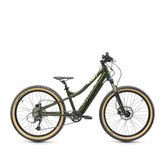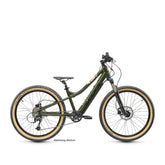Outgrown! This is how you realize that your child needs a bigger bike
On average, a child needs 4-5 wheels in their young life. From the balance bike to the first bike with pedals to the youth bike, the child grows and the bike should always fit well. But: How exactly can you tell whether you actually need a new bike or whether you just need to raise the seat a little? We give tips.
Why the right bike size is so important
In fact, the right size is one of the most important criteria to ensure driving comfort, ergonomics and, above all, your child's driving safety. The bike size should be tailored to the child's height and/or inner leg length and match their motor skills. We would advise against the strategy of buying the bike a little larger so that the children can ride it for as long as possible. In order to be able to move around well and, above all, safely on their bike, your child needs a two-wheeler that fits now - and not in a year.
Too big? Too small? Why neither is good
Kids simply don’t feel comfortable on a bike that’s the wrong size – whether it’s too big or too small. A bike that is too large is not comfortable to ride because it is difficult to reach the pedals, handlebars and the ground. It's harder to act and driving safety also suffers as a result.
On a bike that is too small, however, you sit very uncomfortable and also adopt an unhealthy sitting position. Your knees sometimes hit the handlebars, which hurts and can lead to one or two bruises. In addition, the constant bumping can cause your child to lose balance and fall to the side. The handling is also not optimal here.
When is a bike suitable? Here are a few points:
- The crucial point for the optimal size is the saddle height. Your child must be able to easily reach and pedal the pedals while sitting on the saddle. This is the case if the leg is not fully extended in the lowest pedal position. The thighs should be pulled up to a maximum horizontal position when pedaling. If the legs move higher in the highest position, then the bike is too small.
- Your child must be able to grip the handlebars securely with both hands and smaller children should be in an upright sitting position while riding.
- Kids should be able to touch the ground with at least one foot without having to leave the saddle.
- The height above the frame should allow your child to stand in front of the saddle.
How to determine the right bike size
If you are unsure whether your child should switch to the next bike size, you can use a size chart as a guide. Depending on your height, inner leg length and age, you will be given inch sizes that are suitable in most cases. Mind you, the emphasis is on “orientation” – because individual developmental levels can vary immensely from child to child.
For example, a 7-year-old child who, according to the table, should actually ride an 18-inch bike, might feel much more comfortable on a 16-inch bike, while the tall 5-year-old gets along wonderfully with a 20-inch bike. You can get an overview of the inch sizes of children's bikes here:
Table
Our conclusion
In order to be able to move around well and safely on a bike, your child needs a bike that fits. It should be neither too big nor too small, as both alternatives are not comfortable and affect driving safety.
The saddle height must be high enough so that the pedals and ground can be easily reached and the leg position is correct while pedaling. The knees should not touch the handlebars when pedaling; the sitting position should be more upright for smaller children. So: keep your eyes open when buying a bike and, if in doubt, always take it for a test ride first.




